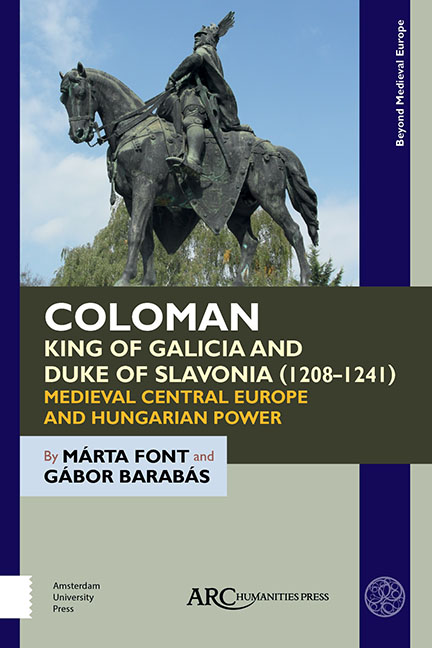 Coloman, King of Galicia and Duke of Slavonia (1208–1241)
Coloman, King of Galicia and Duke of Slavonia (1208–1241) Book contents
- Frontmatter
- Contents
- List of Illustrations
- Foreword
- Introduction
- PART ONE COLOMAN AS CHILD RULER OF GALICIA
- Chapter 1 The Galician Context in 1205
- Chapter 2 The Agreement of Scepus
- Chapter 3 Coloman’s Coronation as King of Galicia: Date and Place
- Chapter 4 The Hungarian Elite and Coloman’s Court
- Chapter 5 Coloman’s Position in Halych, 1215–22: Campaigns and Opponents
- Chapter 6 Upholding the Galician Claim: Coloman’s Place in Hungary
- PART TWO COLOMAN, DUKE OF WHOLE SLAVONIA (1226–1241)
- Chapter 7 Coloman and Scepus, Before 1226
- Chapter 8 Coloman as Duke of Whole Slavonia from 1226
- Chapter 9 Coloman’s Status and the Inner Workings of the Duchy
- Chapter 10 Coloman’s Ecclesiastical and Secular Actitivities in Slavonia
- Chapter 11 Coloman’s Rule in Slavonia
- Chapter 12 Politics and Dynastic Affairs
- Chapter 13 Challenges in the Balkans
- Chapter 14 The Mongol Attack and Coloman’s Death
- Conclusion: Coloman in the Eyes of Posterity
- Bibliography
- Index
PART TWO - COLOMAN, DUKE OF WHOLE SLAVONIA (1226–1241)
Published online by Cambridge University Press: 20 November 2020
- Frontmatter
- Contents
- List of Illustrations
- Foreword
- Introduction
- PART ONE COLOMAN AS CHILD RULER OF GALICIA
- Chapter 1 The Galician Context in 1205
- Chapter 2 The Agreement of Scepus
- Chapter 3 Coloman’s Coronation as King of Galicia: Date and Place
- Chapter 4 The Hungarian Elite and Coloman’s Court
- Chapter 5 Coloman’s Position in Halych, 1215–22: Campaigns and Opponents
- Chapter 6 Upholding the Galician Claim: Coloman’s Place in Hungary
- PART TWO COLOMAN, DUKE OF WHOLE SLAVONIA (1226–1241)
- Chapter 7 Coloman and Scepus, Before 1226
- Chapter 8 Coloman as Duke of Whole Slavonia from 1226
- Chapter 9 Coloman’s Status and the Inner Workings of the Duchy
- Chapter 10 Coloman’s Ecclesiastical and Secular Actitivities in Slavonia
- Chapter 11 Coloman’s Rule in Slavonia
- Chapter 12 Politics and Dynastic Affairs
- Chapter 13 Challenges in the Balkans
- Chapter 14 The Mongol Attack and Coloman’s Death
- Conclusion: Coloman in the Eyes of Posterity
- Bibliography
- Index
Summary
After his ejection from Halych, Coloman moved back to Scepus on the northern border of the kingdom of Hungary where he remained until 1226. At this date he was appointed duke of Slavonia by his father Andrew II. He kept the royal title of king, which he attained in Galicia (despite the loss of that kingdom) and, as a prince in the ruling dynasty, he became responsible for the south-western territories of the so-called Realm of St. Stephen: comprising Slavonia, Croatia, Dalmatia, and several Hungarian counties. As the new Duke of Slavonia, he was subject to his father, and later to his older brother, King Béla IV; nevertheless, within his territory he ruled in the name of the king.
First, we will set Coloman in Scepus after he had left Halych and Galicia, and then his initial years as duke of whole Slavonia, defining how he came to become duke and over which territories he held sway. We will then go on to deal with aspects of this “reign,” including the question of Coloman's titles and government within the duchy; his ecclesiastical and secular activities and relations to Bishop Stephen of Zagreb and the papacy; internal governmental affairs, including his treatment of settlers, neighbouring lands, and the management of estates; his campaign in Bosnia, and finally, his involvement in the Hungarian defence during the Mongol invasion in 1241.
- Type
- Chapter
- Information
- Coloman, King of Galicia and Duke of Slavonia (1208–1241)Medieval Central Europe and Hungarian Power, pp. 61 - 62Publisher: Amsterdam University PressPrint publication year: 2019


